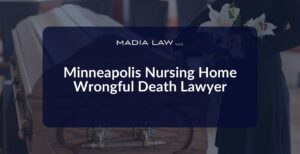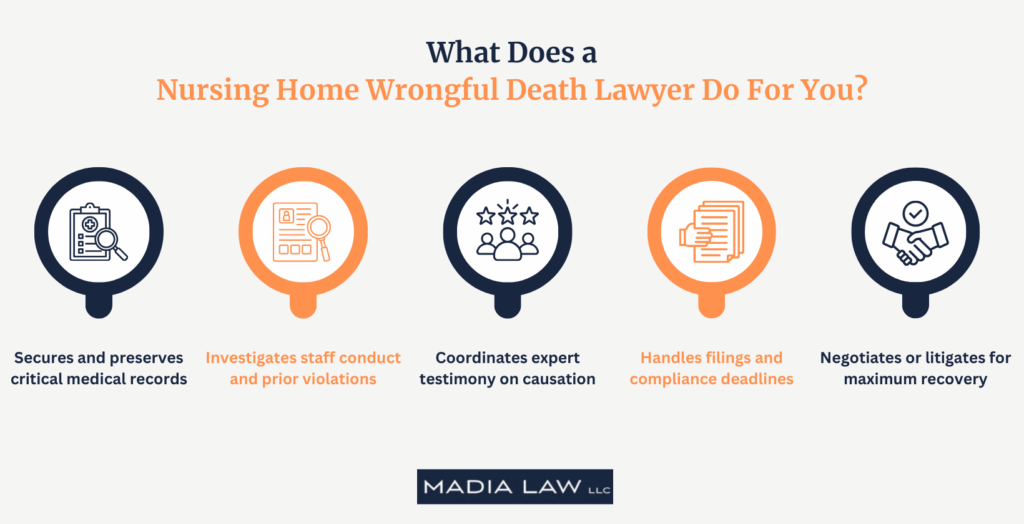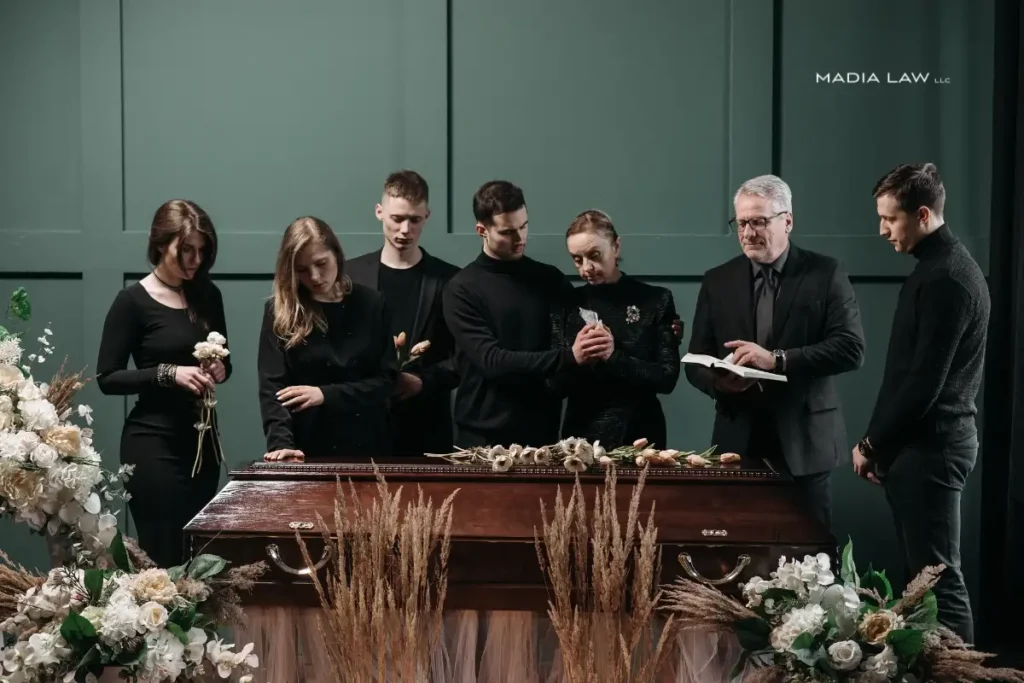
Putting your loved one in a nursing home is already a heart-wrenching decision in itself. But losing them in the same facility you trusted to provide high-quality care due to negligence is painful and life-altering.
If you suspect your family member lost their life in a long-term care facility other than from natural causes, do not wait to report and take legal action. Such actions are unforgivable under Minnesota law, and our nursing home wrongful death lawyer makes sure the negligent party is held legally responsible.
Call us now at 612-349-2729 to schedule a consultation.
Why You Need a Lawyer for a Nursing Home Wrongful Death Lawsuit
While you and your family are trying to cope with the emotional toll suffered from losing someone, nursing homes act quickly to hide evidence, delete official records, and link the death to natural causes, putting their reputation and profit before people’s lives.
Having a wrongful death lawyer by your side helps you fight for answers, secure key evidence, protect official records, and progress your case smoothly under the state’s legal standards to hold those responsible accountable for their actions.
What Qualifies as Wrongful Death in a Nursing Home?
When a resident dies in a high-care facility due to someone else’s negligence and the facility fails to keep them safe, it may qualify as a nursing home wrongful death. The following factors under Minnesota law define whether your case stands in court or not:
Legal Standards That Define a Nursing Home Wrongful Death
Not every death inside a nursing home qualifies for a legal case. For a case to stand, you must prove that:
- The facility owed a duty of care, meaning they had a legal obligation to protect the resident’s safety.
- The facility or staff failed to abide by it due to negligence, carelessness, or a violation of medical standards.
- The breach directly led to the resident’s death.
How Negligence in Care, Supervision, or Medication Qualifies as Wrongful Death
Nursing homes are obligated to provide proper care and supervision to all individuals in their facility. But some often ignore basic facilities like:
- Chronic illness treatment of the patient
- Regular vital checks or wound care
- Supervision near hazards like the staircase or the bed edges
Each of these actions, or say inactions, violates professional obligations of the nursing home, and it can be documented for legal action.
Why Fatal Falls, Infections, or Malnutrition Qualify as Wrongful Death Events
Nursing homes can prevent certain accidents and health issues. But when the nursing home fails to prevent such incidents or knowingly allows them to happen, it often triggers a legal pathway.
Severe falls are often caused by understaffing or inadequate supervision. But nursing homes must have fall prevention protocols in place.
Likewise, sometimes early signs of life-threatening diseases are overlooked, stating them as “just a minor issue or just an old age issue.” Malnutrition indicates long-term negligence as it weakens the immune system, leading to death.
Signs of Abuse or Neglect That Lead to Death in Nursing Homes
You may think there was nothing unusual with your loved one in the facility that caused their death. But some forms of abuse and neglect that lead to the death of the resident do not always look obvious.
Certain physical and behavioral signs point to fatal neglect in care facilities. You may see some common red flags that signal mistreatment, including:
- Bedsores: They are discolored patches of skin that do not change color when pressed and are common in individuals who apply constant pressure to any part of their body, often due to prolonged sleeping positions or immobility. It clearly shows the staff’s failure to monitor the resident and reposition them as needed.
- Dehydration: It commonly occurs when your body uses or loses more fluid than it takes in. Your loved one’s condition before death, including dry mouth, sunken eyes, or confusion, indicates a prolonged lack of fluid intake, directly indicating the facility’s neglect.
- Malnutrition: This occurs when your diet lacks the proper amount of essential nutrients. If your loved one lost weight rapidly or seemed fatigued before their demise, it may have stemmed from the staff’s negligence in ignoring dietary needs.
- Unexplained falls: They can stem from various factors, including medical conditions, old age, and unmanaged conditions within the nursing home. If you see unexplained bruises on your parents, grandparents, or your loved one, it points to understaffing or failure to use mobility aids.
You have a strong basis to pursue a wrongful death claim if your loved one showed any of these signs before passing.
Who Can File a Nursing Home Wrongful Death Lawsuit in Minnesota?
Not everyone is legally qualified to file a wrongful death lawsuit in Minnesota. The right to file a legal claim is limited to specific individuals, including:
- Surviving Spouse
- Adult Children (at least 18)
- Parents (if no spouse or children)
- Court-appointed representative
- Legal guardian (if appointed before death)
Minnesota’s wrongful death statute recognizes these individuals as having “legal standing.” This means if you are one of the above, you can formally pursue compensation and justice on behalf of the deceased.
When Can You File a Nursing Home Wrongful Death Lawsuit?
You must file a nursing home wrongful death lawsuit within three years of the date of your loved one’s death. It does not have to be from when you first suspected negligence.
There are other exceptions. If the negligence is not discovered immediately, the filing deadline may be adjusted. But courts are strict on deadlines. If you miss one, it typically means your claim will be automatically dismissed. It won’t hold in court for even a second.
Act early. Call 612-349-2729 today to schedule a consultation with us and get the justice you and your loved one rightfully deserve!
What Damages Can Be Recovered in a Nursing Home Wrongful Death Case?
Under Minnesota law, your family is able to recover losses for both the financial and emotional impact of losing a loved one. However, what you receive depends on several legal criteria and the strength of the evidence. Our wrongful death lawyers for nursing homes pursue damages in two main categories:
| Economic Damages | Non-Economic Damages |
|---|---|
| Funeral and burial expenses | Loss of companionship |
| Medical bills related to the final injury or illness | Emotional suffering of survivors |
| Loss of the deceased’s pension or financial contributions | Loss of guidance, protection, and care |
| Future loss of inheritance or expected financial support | Loss of intimacy and partnership (for spouses) |
In some cases, you may be able to recover punitive damages to punish the nursing home for letting the incident happen when they knew about it and failed to act. Your lawyer must prove clearly and convincingly that the facility’s conduct involved deliberate ignorance for the safety of its residents knowingly.
Each wrongful death case is different, and so is the amount you recover. Economic damages are based on medical receipts, invoices, and income projections. Meanwhile, non-economic damages focus on the emotional toll on the victim, the absence of a parent, spouse, or caregiver. We collaborate with experts in their respective fields, such as economists and therapists, to calculate and recover the full value of what you have lost.
Steps to Filing a Nursing Home Wrongful Death Lawsuit
Wrongful death claims require a strategic legal process that protects your rights as well as builds a strong case strong enough to hold the nursing home accountable. A qualified Minneapolis nursing home abuse attorney takes a methodical step-by-step approach to increase the overall strength of your case and pursue the justice you deserve.
Here’s a step-by-step approach our lawyers take against nursing homes in wrongful death cases:
- We first review your situation, death certificate, medical history, and any other existing documentation you provide to assess whether we can proceed with the case legally.
- Then, we send a preservation letter to the nursing home to secure the records, as the facility often attempts to destroy medical files, shift logs, or erase surveillance footage related to the case. This legal notice stops that from happening.
- In the next phase, we investigate the facility’s prior violation records and inspection history. This includes checking for Minnesota Department of Health citations, CMS ratings, and complaints to uncover a pattern of neglect.
- Now, we draft and submit the official wrongful death lawsuit in the Minnesota civil court, naming the liable parties, who can include the facility as a whole, owners, management, or even staff members.
- After that, both sides exchange records, take depositions, and secure witnesses to testify on medical care. This is called the discovery phase.
- Finally, the case will be resolved through negotiation, or it will proceed to trial, depending on the nursing home’s response and the evidence.
Minnesota Nursing Home Laws and Resident Rights
Minnesota law provides strong legal protections for nursing home residents. When those laws are violated, high-care facilities can be held civilly liable for abuse, neglect, and even wrongful death. Understanding these laws helps you and your family recognize actions that triggered your loved one’s death and pursue justice.
What Is Minnesota Statute §144.651 and How Does It Protect Residents?
The Minnesota Health Care Bill of Rights, as outlined in statute §144.651, is a law that aims to protect the well-being of patients and residents in healthcare facilities. It outlines over 30 rules for nursing home residents. Some commonly violated rules in wrongful death cases include:
- The right to appropriate medical and personal care according to individual needs at all times
- The right to be treated with respect and courtesy for their individuality
- The right to a prompt and reasonable response to health needs and the right to refuse treatment.
- The right to be free from maltreatment as defined in the Vulnerable Adults Protection Act.
- The right to clean, safe living conditions (patients and residents shall not engage in any labor or services for the facility)
When facilities disregard these rights, they expose residents to significant risks and can be held liable for their actions under civil law.
How Do Minnesota Inspections Help Build a Wrongful Death Case?
The Minnesota Department of Health conducts unannounced inspections of licensed nursing homes. These reports show violations that the nursing home has previously committed (if any), which directly support your wrongful death case.
Out of 377 surveys conducted over seven years in 2017, MDH issued 2,370 deficiencies, averaging 6.3 deficiencies per survey. It was the highest among 6 states within CMS Region V.
The MN Department of Health also worked to improve resident care in nursing homes through different initiatives, including the publication of healthcare provider evaluation and investigation results on its website. This helps people choose the right facility for their loved ones.
Types of Nursing Home Cases We Handle in Minnesota
At Madia Law, our Minneapolis-based lawyers represent families across Minnesota in nearly every form of nursing home abuse. Whether it’s a suspicious death or repeated injuries, our team investigates, prepares, and prosecutes your case with urgency and respect.
Why Choose Our Lawyers to Build a Strong Case Against Nursing Homes
In Minnesota, where reported deficiencies in nursing homes are already high, you need an experienced attorney who not only pursues justice aggressively but also provides compassionate support.
We are civil rights litigators who prepare your case as if it is going to trial from day one. It gives us the leverage to negotiate aggressively when facilities deny liability or delay accountability.
Here’s what sets us apart:
- We have years of experience handling nursing home cases.
- We are trial-tested attorneys who do not fold under pressure.
- We offer client-first communication, always responsive, always personal.
- We have secured over $25 million for clients across Minneapolis and the Twin Cities area.
We care for you, and we want to send a powerful message to the nursing homes and their employees that such inaction is intolerable. Things must not remain the same, and no other family should go through anything like that again.
Speak With a Minneapolis Nursing Home Wrongful Death Lawyer Today
Do not wait if you suspect your loved one’s death was caused by neglect or abuse in a nursing home. You deserve justice, and you deserve a legal team that’s ready to fight for you.
At Madia Law LLC, we have helped many victims across Minnesota seek justice and hold negligent parties accountable. You do not pay us anything unless we win.
Call 612-349-2729 or schedule a no-obligation consultation with us today.



